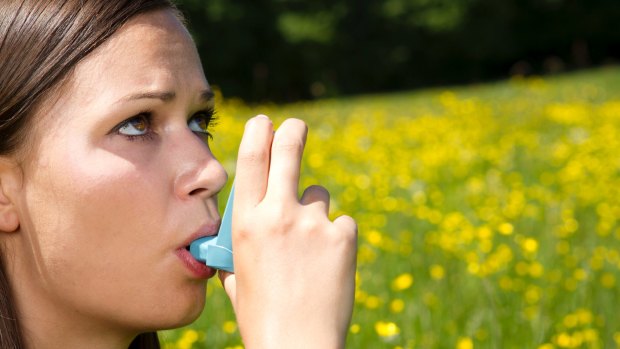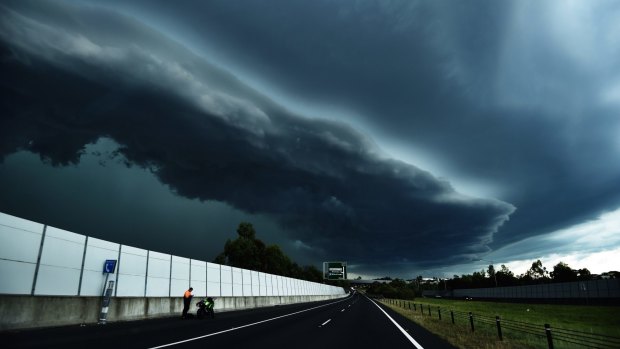This was published 6 years ago
Health experts urge asthma and hay fever sufferers to be prepared as spring sets in
By Esther Han
As the warmth of Spring sets in, health authorities are urging asthma and hay fever sufferers to be prepared for unexpected weather changes that may trigger an attack.
The early warning comes after a storm late last year in Melbourne kicked up pollen and caused them to burst into tiny particles, which penetrated deep into people's airways. It triggered severe asthma attacks and nine people died.
"These weather conditions and high pollen count are not confined to Melbourne. Other areas with temperate climates could also be affected in future," said Associate Professor Janet Davies at Queensland University of Technology.
"Thunderstorm-associated spring time asthma epidemics have happened before in Canberra and parts of NSW."

Spring is here and health experts are urging people with asthma to be prepared.
NSW Health has urged people with asthma to have an asthma action plan and encouraged them to start proactively managing symptoms.
The thunderstorm asthma event in November last year was the largest event of its kind on record globally and contributed to nine deaths being referred to the State Coroner.
It caused 4000 emergency department presentations and more than 30 intensive care admissions.
About one in five Australians is affected by hay fever, and of the 2.5 million Australians with asthma, the vast majority also experience hay fever, according to Asthma Australia.

Storm approaches Blacktown, west of Sydney. A thunderstorm event in Melbourne in November last year triggered severe asthma attacks.Credit: Nick Moir
Pollen, when breathed in, can trigger asthma symptoms such as breathlessness, even in people who do not have asthma.
Professor Davies said data from the AusPollen Partnership showed pollen exposure levels varied widely between regions and between years.
"Last year Melbourne had a moderate to high pollen season but the year before was low – Canberra experienced the opposite and Sydney and Brisbane were also different," she said.
"It's important that people don't make assumptions and use the information resources available to check pollen levels where they live, work and when travelling interstate."
She said although the main trigger was ryegrass pollen during the Melbourne thunderstorm event, sensitivity to fungal spore allergens and tiny particles of pollution could also be contributing factors.
NSW Health's Dr Ben Scalley said while Sydney hasn't had a major event like Melbourne, thunderstorm asthma events have been significant in other parts of NSW, including Wagga Wagga.
"If you have asthma, spring is an important time to make sure you have an asthma action plan and are proactively managing your symptoms," he said.
"For those who suffer from hay fever, and sneeze or wheeze their way through Spring, get checked by your doctor to ensure you don't actually have asthma. If so they can develop a plan for you to manage the symptoms."
An Asthma Australia survey of more than 3000 people who were affected by the freak weather event found 79 per cent experienced an asthma attack, and of those, 92 per cent suffered from hay fever and 40 per cent did not have a pervious diagnosis of asthma.
"We cannot control the weather, but most people can achieve good asthma control with regular preventer use, which helps to minimise the risk of sudden flare-ups," Michele Goldman, chief executive of Asthma Australia.
"People with asthma and hay fever, or people with hay fever experiencing asthma symptoms during pollen exposure should talk to their doctor about a management plan, before spring starts."
It has partnered with 13SICK National Home Doctor Service to raise awareness of the increased risk of asthma and hay fever during the pollen and thunderstorm seasons.
"The best thing for people to do in the event of a thunderstorm is keep indoors with the windows and doors shut until the storm has passed," said Dr Natalie Caristo of 13SICK.
If someone near you is having an asthma attack, sit them upright, given them four separate puffs from their reliever puffer, and wait four minutes.
If there are no signs of improvement, give four more puffs, and if there's still no improvement, call the ambulance.
Each year, about 10,000 people are admitted to NSW hospitals for treatment of asthma. Around one in nine adults and one in eight children has asthma in NSW.